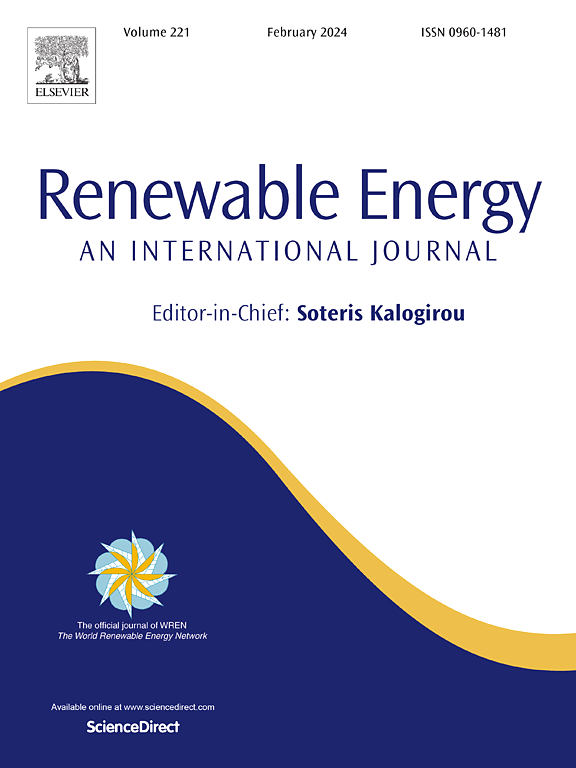新型集成光伏集热系统的热性能优化
IF 9
1区 工程技术
Q1 ENERGY & FUELS
引用次数: 0
摘要
建筑行业正在积极寻求节能解决方案,以减少对化石燃料的依赖。光伏光热(PV-T)建筑一体化系统将发电与太阳能热利用结合在一起,已成为一项前景广阔的技术。然而,传统的光伏热系统在实现最佳光伏板角度以获得最大太阳能增益的同时保持建筑美观方面往往面临限制,尤其是在与建筑外墙集成时。本研究调查了专为应对这些挑战而设计的新型光伏集热(PV-TC)系统的热性能。该系统用于安装在朝南的建筑外墙上,可灵活设计光伏板的角度,在不影响建筑美观的前提下优化太阳能捕获。我们采用基于模拟的优化方法,利用 EnergyPlus、Radiance 和遗传算法来确定最佳设计参数,以最大限度地降低中国南京气候条件下的年能源使用强度(EUI)。结果表明,288 m³/h 的风扇转速、21 °C 的冬季风扇设定值、25 °C 的夏季风扇设定值以及 41° 的光伏板角度可实现最低的 EUI(92.33 kWh/m2)。这种优化配置有效地平衡了发电和太阳能热利用,最大限度地减少了对传统暖通空调系统的依赖。我们进一步分析了各个参数的影响因素,结果表明,增加风扇转速可持续提高传热效率,而最佳光伏角度和风扇设定点温度则分别对最大限度地利用太阳能热量和夜间制冷至关重要。通过比较发现,安装 PV-TC 系统后,每年的 EUI 降低了 22.7%。这些研究结果为设计和运行高性能的光伏-热电联产系统提供了宝贵的启示,从而解决了建筑节能和建筑一体化的问题。本文章由计算机程序翻译,如有差异,请以英文原文为准。
Thermal performance optimization of a novel integrated photovoltaic thermal collector system
The construction industry is actively seeking energy-efficient solutions to reduce reliance on fossil fuels. Building-integrated photovoltaic thermal (PV-T) systems, combining electricity generation with solar heat utilization, have emerged as a promising technology. However, conventional PV-T systems often face limitations in achieving optimal PV panel angles for maximum solar gain while maintaining architectural aesthetics, especially when integrated into building facades. This study investigates the thermal performance of a novel photovoltaic thermal collector (PV-TC) system specifically designed to address these challenges. This system, intended for installation on south-facing building facades, allows for flexible PV panel angling design to optimize solar energy capture without compromising the building's aesthetic appeal. We employ a simulation-based optimization approach using EnergyPlus, Radiance, and a genetic algorithm to determine the optimal design parameters for minimizing annual energy use intensity (EUI) in Nanjing, China's climate. Our results demonstrate that a fan rate of 288 m³/h, a winter fan setpoint of 21 °C, a summer fan setpoint of 25 °C, and a PV panel angle of 41° achieve the lowest EUI of 92.33 kWh/m2. This optimized configuration effectively balances electricity generation with solar heat utilization, minimizing reliance on conventional HVAC systems. We further analyzed individual parameter influences, demonstrating that increasing fan rate consistently improves heat transfer efficiency, while optimal PV angle and fan setpoint temperature are crucial for maximizing solar heat utilization and nighttime cooling, respectively. By comparison it was found that the installation of the PV-TC system reduces the annual EUI by 22.7 %. These findings provide valuable insights for designing and operating high-performance PV-TC systems that address both energy efficiency and architectural integration concerns in buildings.
求助全文
通过发布文献求助,成功后即可免费获取论文全文。
去求助
来源期刊

Renewable Energy
工程技术-能源与燃料
CiteScore
18.40
自引率
9.20%
发文量
1955
审稿时长
6.6 months
期刊介绍:
Renewable Energy journal is dedicated to advancing knowledge and disseminating insights on various topics and technologies within renewable energy systems and components. Our mission is to support researchers, engineers, economists, manufacturers, NGOs, associations, and societies in staying updated on new developments in their respective fields and applying alternative energy solutions to current practices.
As an international, multidisciplinary journal in renewable energy engineering and research, we strive to be a premier peer-reviewed platform and a trusted source of original research and reviews in the field of renewable energy. Join us in our endeavor to drive innovation and progress in sustainable energy solutions.
 求助内容:
求助内容: 应助结果提醒方式:
应助结果提醒方式:


